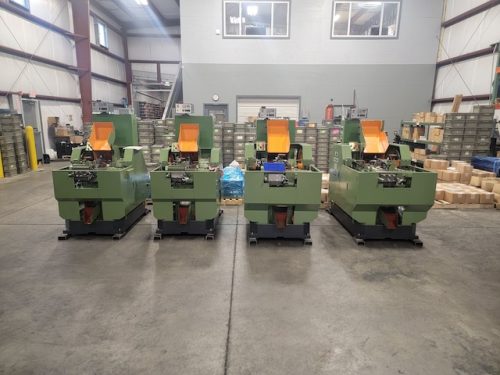Excitement is palpable here at Crescent right now as the integration process of our new state-of-the-art heading machines is well underway. In just a few weeks, as we complete the process of adding the heading machines to our shop floor, we anticipate a significant transformation that will enhance our production capacity and output. These new machines mark a notable milestone in Crescent Manufacturing’s journey, representing a substantial investment in our future production capabilities. Our entire team is eagerly looking forward to witnessing these new headers in action. Not only are they faster than our current machines, but they’re Crescent’s first investment in new production equipment in many years!
But what exactly is a heading machine, and why is it so vital for our manufacturing processes?
A heading machine, also known as a “header” or “cold heading machine”, is a type of machine used in manufacturing to shape and form metal parts, (typically fasteners like screws, bolts, and rivets). A heading machine works by cold-forming metal wire or rod stock into the desired shape through a process called cold heading or cold forging. This process involves placing the metal stock into a die cavity and applying pressure to shape it into the desired form, often with multiple steps to achieve complex shapes. Heading machines are essential in a variety of industries where high volumes of precision metal parts are required.
What are some advantages of heading machines?
- High Production Speed: Capability to produce parts at high speeds, making them ideal for mass production and meeting high-volume demands.
- Cost Efficiency: Reduction in labor costs associated with the manual forming of metal parts by automating the cold healing process.
- Material Savings: Minimal material waste by requiring less material removal compared to traditional machining methods.
- Improved Material Properties: Improvement of the material’s mechanical properties, such as strength and hardness, due to the cold working of the metal.
- Consistency and Precision: Production of consistent dimensions and shapes, ensuring uniformity and reliability in the manufactured components.
- Complex Shape Formation: Ability to form complex shapes with multiple steps, allowing for the production of a wide range of parts, including fasteners with various head styles and configurations.
- Reduced Secondary Operations: The near-net-shape forming capabilities of heading machines often eliminate the need for additional machining or finishing operations, reducing production time and costs.
- Versatility: Ability to be adapted to handle various materials, including steel, aluminum, copper, and alloys, making them suitable for diverse manufacturing applications across different industries.
In modern manufacturing facilities like Crescent Manufacturing, heading machines are essential equipment that provides a cost-effective, efficient, and precise method for producing high-quality metal parts in large quantities to serve customer needs.

